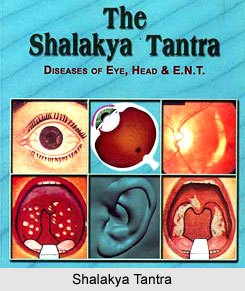 Shalakya tantra, a specialized branch of the Ashtang Ayurvedic tree, deals with the treatment of diseases located above the neck. This branch is concerned with the causes, diagnosis, prophylactic measures and the curative procedures of the diseases of the head, ear, nose, eye and throat. Different methods are available for the treatment of these problems.
Shalakya tantra, a specialized branch of the Ashtang Ayurvedic tree, deals with the treatment of diseases located above the neck. This branch is concerned with the causes, diagnosis, prophylactic measures and the curative procedures of the diseases of the head, ear, nose, eye and throat. Different methods are available for the treatment of these problems.
The treatment is mainly done by using shalaka, which means a rod or a probe, a technique which has given shalakya tantra its name. With the help of the rods or probes, medication is applied to the affected parts. Various kinds of probes are used by the practitioners of shalakya tantra. Probe of the eye (netra shalaka), probe of the ear (karna shalaka ), that of the nose (nasa shalaka ), of the throat (mukh shalaka), of the lips (oshta shalaka) are a few to mention. Since it treats ailments above the neck, this branch of Ayurveda is also known as Urdhvanga chikitsa (treatment of the organs whish reside in the uppermost part of the body).
Shalakya tantra finds explicit mention in Ayurvedic texts such as Sushrut Sanhita, Charak Sanhita and Ashtang Hruday (which literally means the heart of the eight-branched tree of Ayurveda). 72 diseases of the eye (netra rog) have been discussed here including conjunctivitis (sarvakshi rog), cataract (linganash), pre-glaucomatic condition and glaucoma (timir) and diseases of the iris or pupil (drushti rog).
Besides these , 25 diseases of the ear (karna rog), 18 diseases of the nose (nasa rog), 11 diseases of the lips (oshta rog), 1 disease of the lymph glands (gand rog), 23 diseases of the teeth (danta rog), 6 diseases of the tongue (jivha rog), 8 diseases of the palate (talu rog), 18 diseases of the throat , pharynx and larynx taken together (gal rog) and 8 diseases of the oral cavity (sarvagat mukhrog) have been catalogued. In addition to this, surgical techniques for the removal of tumors, abscesses and cysts (arbuda), ways to eliminate foreign bodies in the region above the neck are enlisted in the shalakya tantra.
Common problems like wax in the ear, dryness of the eyes or the throat, migrain and their simple home remedies have been precisely dealt with in the three above -mentioned Ayurvedic texts. These home remedies have been largely adopted and are in rampant use even today. Shalakya tantra is concerned not only with the immediate treatment procedures of the ailments but also with the follow-up treatment of all these problems, an aspect which modern medicine considers vital.
When shalakya tantra originated in the ancient period (about 600 B.C.), anesthesia or aseptic precautions were nowhere in the scene. But Ayurvedic sages have described ashchotananjan-vidhi (putting ayurvedic medicinal drops in the eyes) and putpak-vidhi (covering the eye with a smooth medicated cloth or tree leaf) to avoid the spreading of infections.
According to Sushruta, the first surgeon in the history of ayurvedic medicine, putpak-vidhi is very useful and essential part of ophthalmologic treatment. A specific therapy that embraces all these procedures step by step is discussed in details in the Sushrut Sanhita.
Thus Shalakya tantra includes the treatment of almost every disease in and around the head, ranging from day to day problems to complicated ailments. This branch clearly testifies that Ashtang Ayurveda was a science which not only treated advanced diseases but also common health problems.





